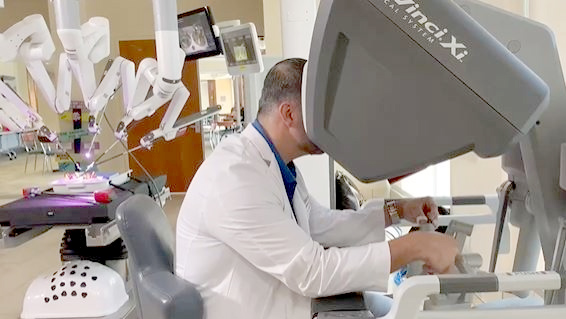
Special
For AL DIA TODAY
PALM BAY — It doesn’t have a steering wheel (or seat belts). You can’t take it out on I-95. And it won’t even top one mile per hour.
But Health First’s Palm Bay Hospital associates, visitors and patients had an opportunity on Wednesday to “test drive” the hospital’s new da Vinci Xi robotic surgery technology – bringing to seven the total number of robotic surgery units in the Health First network.
Surgeon Dr. Mohamad Hammoud said that the event at Palm Bay Hospital was a natural way for Health First to better educate the public on the availability and benefits of the minimally invasive surgical technology
“Unveiling and sharing this technology today with our associates, visitors and patients is an excellent way to educate them on the benefits of robotic surgery,” said Dr. Hammoud. “Wellness and healing begin with education and communication, and there is no better way to share information than a hands-on opportunity. This is a lot of fun for our associates, and we want them to be excited and proud of the technology we offer at Palm Bay Hospital and Health First.”
Robotic surgery is not exactly a new concept – it’s actually been in existence for approximately 25 years – but the technology continues to improve and expand in use across the U.S.
Health First has offered robotic surgery in Brevard County since 2014, and more than 12,000 surgeries have already been successfully performed. Patients who undergo robotics-assisted surgeries have a length-of-stay in a Health First hospital of approximately 1.5 days vs. national average for standard, large incision “open” surgeries of 5 -to-15 days.
According to Dr. Hammoud, the minimally-invasive precursor to robotic surgery was laparoscopic surgery, which utilized much smaller incisions, along with smaller specialized surgical tools.
With robotic surgery, the surgeon makes tiny incisions (laparoscopic) and inserts miniaturized instruments – including a tiny a high-definition three-dimensional camera. From a nearby (videogame-like) console, the surgeon manipulates the robot’s attached arms/devices. The robot translates the surgeon’s movements in real-time, mimicking moves precisely on the screen. The surgeon is in control the whole time – the robot responds to the direction she or he makes.
“Laparoscopic eliminated the need for large incisions during surgery,” said Dr. Hammoud. The smaller the incisions, the better recovery for the patient. Minimally invasive surgery reduces pain, blood loss and scarring. Patients leave the hospital and get back to their daily lives sooner.
“Robotic surgery is the evolution of laparoscopy, Dr. Hammoud continued. “The robot is an accessory tool that you have at your fingertips to make surgery a lot easier – and safer. I’m still the surgeon. The robot is not doing anything on its own. I have to control it – but it allows me to have tools and autonomy that I wouldn’t ordinarily have in a very tightly controlled space.”
Not only does robotic surgery improve surgical outcomes, it is also a tremendous gamechanger for the surgeon. Prior to laparoscopic and robotic technology, a surgery – such as a hernia repair operation – could take two hours or more. In some of these surgeries, the surgeon spends hours standing and/or bending over the patient and surgery site, which over time becomes uncomfortable and tiresome. Robotic surgery cuts the surgery time dramatically, while the surgeon remains seated at the console.
“There is a lot of fatigue in surgery. How does this help you perform as a surgeon? Historically as surgeons, we never want to think about ourselves. We always want to take care of the patient and make sure we perform the procedure safely. But the reality is, if you’re standing, bending for 8 hours or more each day doing surgeries, it does naturally take a toll over time physically and mentally.
“Again, we are now able to perform many procedures safely in a fraction of time – which benefits the patient in many ways, as we’ve outlined. But it will also be a gamechanger for the future of surgery and surgeons by removing the physical effects on the surgeon over time – allowing them to continue performing surgeries perhaps much longer than they might otherwise. And…. this technology actually makes surgery fun.”
Although robotic surgery is not an option at this time for all surgical procedures, it continues to evolve. In addition, there are still many surgeons who have not yet adopted the newer technology. Dr. Hammoud recommends patients needing surgery ask about robotic surgery as an option from their surgeon – or seek a second opinion.
“At the end of the day, an educated and informed patient is the best kind of patient,” said Dr. Hammoud. “We want our patients and their loved ones to be informed and gather as much information they can, ask questions, and understand their options. It certainly makes them more comfortable and at ease with the process, and we feel better knowing they are fully on board.”
